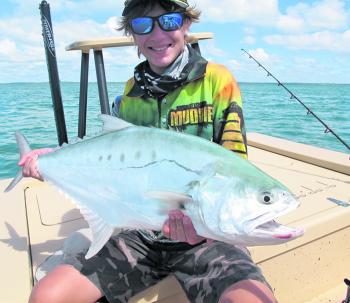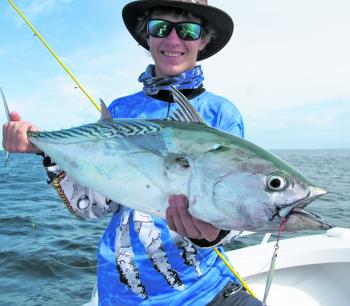Currents play a major part in fishing, whether you are dropping jigs or plastics onto offshore reefs, casting lures around inshore structure or even soaking some baits upstream – the way we fish and the success we have is all dependent on the winds of the ocean.
Predatory fish love to wait in ambush locations where there is shelter, snags and other underwater obstacles. These spots are perfect as they can not only stalk their prey and stay hidden from sharks or larger fish, but also stay sheltered from the raging currents that would otherwise sweep them away.
At different stages of the tides currents can flow faster, harder, and in different directions. This affects the way fish use their cover. On the slack tide, fish will often venture out of their oasis and forage for food in the surrounding area but when the tide begins to push they will position themselves where they are out of the current and where they are safe from predators. Deep holes and eddies behind rock bars or sand banks serve a similar purpose, and schools of fish are often observed on the sounder performing these activities at different stages of the tide. When the fish hug the bottom or against their shelter they are often very hard to get a bite from. At this stage they become shut down and are primarily focused on holding their position. When they arise from the seabed or leave their snag they are hunting, and this is when they will be interested in your lure or bait.
An example of this is when Dad, Grandad, and I headed out on the Mary one afternoon to fish the drains and gutters. It didn’t take us long to find a large school of threadfin hugging the bottom in the mouth of a large deep gutter, but it was high tide and the currents were raging, the fish were clearly not in the mood to bite, so we spent a good hour for nothing, before moving on to fish elsewhere. Later that afternoon, we returned at low tide and the fish where still there, but now they were swimming high in the water column and were actively swimming around. Grandad dropped a Gold Bomber behind the boat and within seconds he hooked up to a 1.2m monster. It had been a while since he had caught a decent fish and it sure gave him a workout! This just goes to show that the stage of the tide, the depth or clarity of the water and of course the strength of the flowing currents greatly affects the feeding patterns and behaviours of fish.
When fish show up on the sounder but aren’t showing the right signs, or if you are struggling to get a hook-up it is best to leave the fish and return on the slack tide when they begin to feed, otherwise you could spend frustrated hours when the fish aren’t even interested.
tThis explains how reef and river fish often behave, but pelagic fish are another story.
Ocean-going fish like tuna and mackerel aren’t as affected by the tides in the sense that they don’t require shelter. They’ve evolved to keep swimming and don’t need to rest in calm water. While this is true, they may hang deep near the bottom or not be as aggressive feeders at different stages of the tide, and you may have to vary the lures and baits you use when this occurs.
Oceanic currents are essential for the spawning of many fish species, and affects when and where pelagics swim. For example, the famous run of juvenile black marlin in Hervey Bay doesn’t occur every year, and when it does the number of fish around, the depth they prefer to swim in and even how long the season lasts can vary. This all depends on where the currents take them. Other species like tuna, queenfish and trevally can be affected in similar ways. Inshore rock bars, deep holes and snaggy country should be fished at different times of the tide and different levels of light, and you should commit to a thorough experiment to determine what lures or bait are the most effective for the target species. It is wise to scan the area with a sounder to see if the structure holds fish and how they are behaving before you start fishing.
For offshore activity, local knowledge of the fish behaviour, and an examination of what they are feeding on will help, but the only real way to figure out pelagic fish is through trial and error. Inshore species targeted around current-affected areas include queenfish, barramundi, threadfin salmon, tailor, flathead and even giant trevally. Using the currents to your advantage when working lures and positioning baits can catch these species. Use the currents in a similar way to target tuna, mackerel, trevally, cobia, marlin and of course the abundance of reef fish.
Another tip with this kind of fishing is to find the schools of bait to, in turn, find the fish. The match the hatch policy is particularly important in this situation. Baitfishing is much more effective in running water, where the scent of the bait will be washed with the current. In still water it will take much longer for the scent to waft out into the surrounding body of water. Remember this kind of fishing can be pretty high tech and complicated and could take years of practice to figure out, so don’t be worried if you fail the first few times, persistence pays off.
Best of luck to all anglers!
Reads: 5596
This big queenie ate a soft plastic worked over an inshore reef on the slack tide.

Livo with a 15kg river giant trevally caught in a hole, while the current was strong.

Grandad displays his cracker thready caught in a deep gutter. The fish were showing good signs when viewed on the sounder, such as swimming high in the water column.

Pelagic species like mac tuna may only feed on the surface at certain stages of the tide when the bait is schooled up. A Gomoku jig rigged like a slug worked well on this particular day, it matched to small hardiheads exactly.

Pelagic species like black marlin may only turn up in areas like Hervey Bay if the oceanic currents funnel them in the right direction.




